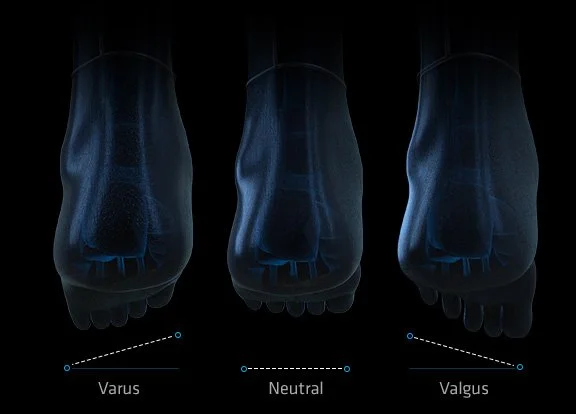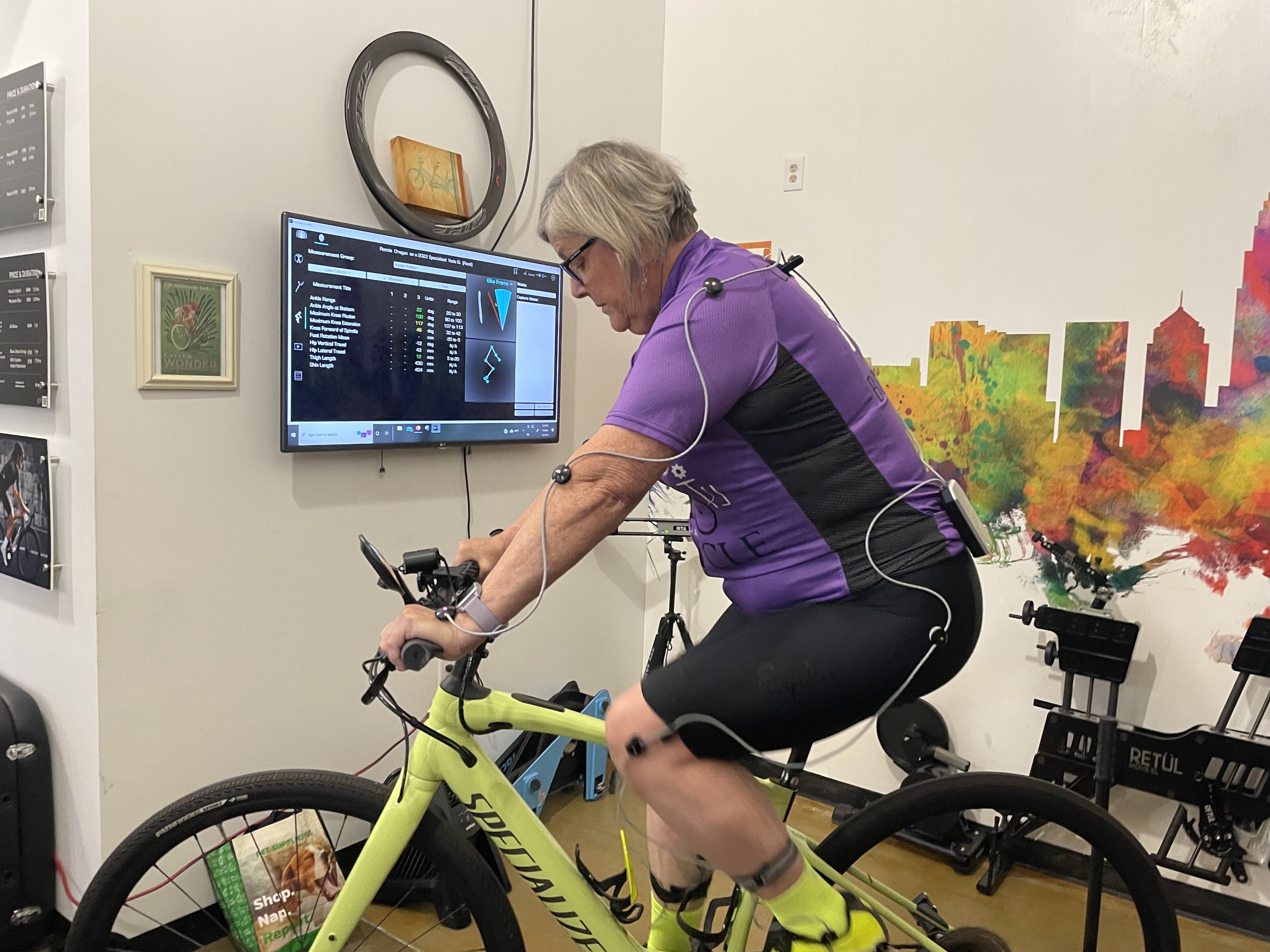5 Reasons Why a Bike Fit is For Every Body
Back in 2020 when everyone’s world got flipped upside down due to COVID-19, no one anticipated the spark it would ignite for the desire to get outside and ride a bike. During this time, there was also a huge uptick of riders buying bikes and equipment. Retailers literally could not keep their shelves stocked. According to People for Bikes, an industry coalition based in Colorado, 1 in 10 American adults report having ridden a bike for the first time in a year (or longer) since the onset of the Covid-19 pandemic.
Fascinatingly, according to AARP, 22% of those who started cycling during the pandemic were aged 60-79. When Americans were suddenly confined to their homes, they seemingly embraced cycling as a great way to destress, get in cardiovascular activity without putting significant strain on joints in the body, and even commute. For many of these new and renewed cyclists, bike fit was not a consideration or limited to the knowledge of the person helping them on the sales floor.
In this post, we have asked Retül Certified fitter Andrew Lerner of Conte’s Bikes in Charlotte, NC to provide his perspective on the top five reasons all riders should have a proper bike fit and why it is important.
Andrew Lerner- Conte’s Bike Shop
“While many people (and some bike shop employees) think bike fits only benefit racers, cross-country mountain bikers, or triathletes, I disagree. Most cyclists want to get outside to experience the benefits of cycling and enjoy themselves. Riding a bike is all about having fun, and you can't have fun if you're not comfortable, and you can't get comfortable unless you are properly fit to your bike.” States Andrew.
Andrew grew up ski racing in Vermont before moving south and transitioning his passion from skiing to triathlon and cycling.
"When I made the change, I wanted to learn everything I could. Growing up ski racing, I had no idea why I should eat gels or how to choose faster tires for a race. Luckily, I had some great friends and mentors (shout out to James H and Melissa B) to help. Triathlon sparked an interest in me, and fortunately, it afforded me the opportunity to go back to school to pursue a career I am passionate about."
Andrew and Ronnie during her fit session at Conte’s in Charlotte, NC
Andrew will be taking it from here to talk through his top 5 reasons why a bike fit is for every body, while providing real-life examples from his fit client Ronnie, who has graciously agreed to share feedback on her experience being fit on the Specialized Turbo Vado SL 4.0.
Before being Retül trained, I worked with Chris Duffy, Director of Bike Fitting at Conte's Bikes, who impressed a few foundational practices on me that I still follow during every fit.
I’ve pulled together my top five reasons why bike fits are for everyone, especially as we get older, and I’ve sprinkled in a few DYI tips and tricks to help you get started at home. By following my tips, and visiting a Retul-certified bike fitter, you should start enjoying your time on the bike and having even more fun.
Summary of topics:
A bike is symmetrical, humans are not
Feet are your foundation, invest in them
The hips don’t lie
Hand position is the product of a good bike fit
Get your bike fit checked annually
A bike is symmetrical, humans are not
Most people have anatomical asymmetries, and these asymmetries manifest as discomfort on the bike. For example, many cyclists I fit have one leg that is longer than the other. This asymmetry can cause the knees to bow out on one side and not the other; as a result, cyclists often complain of knee pain or frustration with their inefficiency on the bike. Even more concerningly, their likelihood of injury is increased. A bike fitter's goal is to adjust the bike to compensate for those asymmetries
With Retul 3D motion capture, we can identify these asymmetries to a millimeter and adjust the bike to the rider. You’re probably asking, But do a few millimeters on one side or the other make a difference? Well, think of it this way, if a cyclist who slightly overpronates by 5mm one their right-side rides for 10 miles over 45 minutes with an average cadence of 70rpm, their right leg has moved almost 55 extra feet compared to their left. So yeah, it does make a difference.
Studies show that the discrepancy between the left and right legs can be very consequential. In one study from the Journal of Sports Medicine Physical Fitness, six highly trained competitive male cyclists rode a simulated 40km time trial on an SRM cycle ergometer that measured the force exerted by their left and right leg at the crank. The discrepancy between the left and right leg varied through the time trial but averaged around 13-17%. Imagine how powerful and efficient you could be if all that effort was evenly distributed!
2. Feet are your foundation, invest in them
Think of a house built on a crooked foundation; how safe would you feel sleeping on the 3rd floor? The same logic applies to the body. Because feet are the body's foundation, poorly supported feet have a cascading effect of complications throughout the body.
For example, an unsupported foot causes misalignment between your foot-knee-hip, which in turn, leads to less pedal power and stability and an increased likelihood of injury. Therefore, supporting the foot is very important. Bike fitters assess a rider's feet to quantify how they move in 3D space to help determine what stabilization and support might be needed
Once you identify the unique needs of your feet, you can optimize support/stability with standard products like the Specialized BG footbeds, or custom-built footbeds that meet the precise needs of each foot.
Andrew making a pair of Body Geometry Custom Footbeds for Ronnie
Ronnie was a perfect candidate for custom insoles because one of her feet had more pronation than the other, causing misalignment when pedaling. While a standard footbed might work on one foot, it would leave the other lacking the support it requires, which would then cause the non-supported ankle to fall medially, generating a ripple-like effect up the leg to the spine.
If you use clip-less shoes, the correct cleat position and pedal system are essential to efficient injury-free pedaling. Cleats positioned too far forward will overwork the calf (think of a ballerina standing on their toes), while cleats positioned too far back will strain the upper leg muscles. In both scenarios, the fatigued muscle will cause pain, cramping, and a seriously reduced power output. There are many different types of pedal systems and shoes so chatting with your bike fitter helps determine which is best for you.
Take Ronnie here for example, as she’s aged, (like most Americans) she’s lost strength, endurance and flexibility — factors that have affected her coordination, stability and balance (Mayo Clinic- Aging: What to Expect).
“When I hit [age] 70 I noticed a perceptible difference in my cycling conditioning. So much so that I started to ride less and lower the mileage of each ride. I literally saw friends riding away from me. And there are fewer 70-year-old women riding out there, so my core group has withered away and I find that I’m riding with younger people.
Ronnie goes on to explain, “The E-Bike brings the possibility of riding for many more years and the ability to drop into groups of varying abilities and speeds. I’m hoping for longevity in my cycling lifestyle.
Along with converting to the E-Bike, I want to have the most accurate fit on the bike to reduce the wear and tear on my muscles and joints. I am finding some problems with moving from drop to upright handlebars. New aches and pains are popping up, particularly in my hands and elbows, and I want to correct them before the issues become so uncomfortable that I might stop riding as frequently as I want.”
Showing the Bythlon Safety Pedal System
For those reasons, we chose a unique pedal system that allows Ronnie to get the feeling she is used to of a clip-in pedal while letting her feet step out easily in case of a quick stop. The cleat should be installed with the 3rd metatarsal (think of the knuckles on your feet) directly over the pedal spindle, and the 1st metatarsal in front of it. This will help reduce pressure and hotspots on your feet. For cleat rotation, try some basic at-home tricks to determine if a slight toe-in/toe-out angle could help.
First, sit on a stool or chair so that your feet cannot reach the floor and look at which direction your feet naturally hang.
Next, squat with your feet facing forward and your hands above your head, note whether your knees point in a direction other than straight ahead.
Finally, adjust the cleat to accommodate to your body's natural motion.
This small change should significantly improve comfort and make you more efficient so you can have more fun on rides.
3. The Hips Don't Lie
I don't care how comfortable the saddle cushioning may feel or what your neighbor claims is the best saddle; if you're not sitting squarely on your "sits" bones, the saddle will be a literal pain in the butt. A proper fit includes a pre-fit rider interview to record pertinent information that, combined with our Retül Digital Sitbone Device (DSD for short), allows us to use data to make a scientific saddle choice.
When a saddle is the wrong width, either too wide or narrow, the rider risks sitting on soft tissue, which can cause twisting of the hips and spine. The DSD digitally measures the width of the riders sits bones to determine the correct saddle width for the rider.
In Ronnies case, as a regular cyclist who bikes in an upright active position, she found the Specialized Power saddle with Mirror technology to be her glass slipper. She found the saddle’s hammock-like effect correctly supporting her sits bones in its 3D-printed matrix so that she is not putting any pressure on any soft tissue surrounding her sits bones.
After ensuring you are supported on the correct saddle, the next step is determining your ideal saddle height.
Setting the saddle too high can causes the hips to rock and twist, while setting the saddle too low causes excessive strain on the knee. There are many techniques to determine what is right for you, but a good rule of thumb is that while pedaling, your knee should be slightly bent (about 10 degrees) at the bottom of the pedal stroke. If your knee is locked out at the bottom of the stroke, your seat is too high— if you feel like your leg never gets any rest, it might be too low.
Setting the saddle height isn't just about leg length; it's also about flexibility. If you spend most of your life sitting at a desk from 9-5, you might want to start with a slightly lower saddle. This is because sitting in a chair causes your hamstrings to tighten and, because your hamstring originates from the Ischial Tuberosity (part of your sits bones), a tight hamstring tends to pull the pelvis to a more upright position, causing the rider to bend at the lower back and revert to sitting on "soft" tissue.
4: Hand Position is the Product of Good Fit
Your neck, hands and shoulder will help you confirm that your feet are supported, that you have the ideal saddle, and that your cleats are oriented correctly. You might still have to make a few tweaks to your handlebars and stem to help with numb hands or sore necks. In most cases of numb hands, relieving some weight off your hands or shoulders usually does the trick. To help take the weight off your hands, you can change the height of your handlebars by raising or lowering them, or by changing the length and angle of your stem.
Are you stretching to reach the bars? Or is your neck sore when riding? Do your wrist, elbows, and shoulders line up with each other? We don't want the joints to be perfectly straight and outstretched like Frankenstein’s monster. Instead, we look for a natural arm arc when reaching for the handlebar. Imagine your arm as you swing your hand up to shake someone's hand; instead of the hand, you are grasping for the handlebar. You want a neutral line from the forearm into the hands so that the wrist isn't cocked or bent. To achieve this, you may have to adjust the handlebars' rotation, position, or grip shape.
With Ronnie, we selected a stem with more height (called rise) to take some pressure off her hands and cut the bars to a width that fit her anatomically (most flats bars come wide, and bike companies expect that riders will cut them to suit).
She also picked grips that featured soft economic support with a contoured design to support the palm of her hand, which helps to evenly distribute hand pressure, further helping to reduce numbness and aching in the hands and forearms. Because Ronnie had a lagging neck issue, making it more difficult to turn to look behind her than in her youth, we installed a mirror that will assist her in feeling safe when out on the road training for an upcoming MS150 ride.
5. Get your bike fit checked annually
Ronnie getting ready for a cooler ride with her friends in Charlotte, NC.
Our bodies change as we age, making your bike fit dynamic. People's flexibility and adaptability change over time. When we're young, we're relatively flexible and adaptable, but as the years progress, we experience attrition, injuries and the impacts of sitting for long periods of time. All these changes affect your balance and make your joints stiffer. While there isn't one ideal position written in stone, there's an ideal saddle height, saddle setback and reach for each phase of your life. Staying up to date on your bike fit will ensure you’re continually adjusting to be as efficient, safe, comfortable, and happy on the bike as possible.
Ronnie also had this to say, “Your fitting expertise, using the Retül process, is key to making small and imperceptible changes in positioning. By taking the metric data and converting it into technical adjustments insures my proper positioning and fit on the bike resulting in corrections that will keep me healthy and riding longer. Thank you again for taking me through the Retul fitting.
Still trying to figure out where to start? Check out the Retül find a Fitter page. Or go into your local bike shop, start a conversation with their bike fitter, and describe what you experience on the bike; I promise they will want to help.
After all, people do not get into bike fitting for fame and money; we do it because it's our passion; we get to help people along their "cycling journey" while we play with bikes all day, jackpot!
Thank you so much to Andrew for his contribution and spreading the word about the importance of a proper bike fit. We hope many riders will find this information helpful to how to be more comfortable on the bike, what you can do at home, and how a professional bike fit will provide that extra personalization.
When Andrew is not fitting or riding bikes, you can find him working in his garden, supporting animal rescue groups, eating creamies, and having fun with his partner Erin, their two dogs and one cat who thinks he's a dog.
You can find Andrew through the following social links, Instagram and Facebook, or contact through Conte's Bikes.










